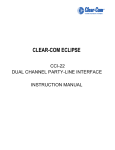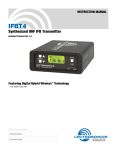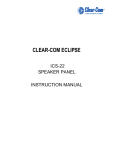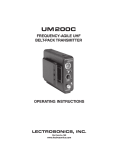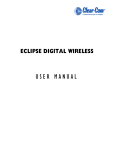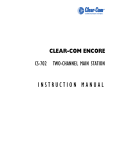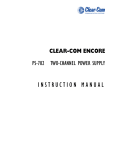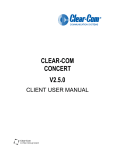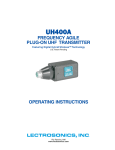Download Clear-Com Cellcom Instruction manual
Transcript
CLEAR-COM WIRELESS IFB PTX-3 UHF DIGITAL HYBRID IFB TRANSMITTER INSTRUCTION MANUAL PTX-3 UHF Digital Hybrid IFB Transmitter Instruction Manual © 2008 Vitec Group Communications Ltd. All rights reserved. Part Number 810401Z Rev. 2 Vitec Group Communications LLC 850 Marina Village Parkway Alameda, CA 94501 U.S.A Vitec Group Communications Ltd 7400 Beach Drive IQ Cambridge Cambridgeshire United Kingdom CB25 9TP Vitec Group Communications Room 1806, Hua Bin Building No. 8 Yong An Dong Li Jian Guo Men Wai Ave Chao Yang District Beijing, P.R. China 100022 ® Clear-Com, CellCom/FreeSpeak and the Clear-Com Communication Systems logo are registered trademarks of The Vitec Group plc. CONTENTS Introduction . . . . . . . . . . . . . . . . . . . . . . . . . . . . . . . . . . . . . . . . . . . . 1-1 Digital Hybrid Technology . . . . . . . . . . . . . . . . . . . . . . . . . . . . . . . . . 1-2 Audio Input Interface. . . . . . . . . . . . . . . . . . . . . . . . . . . . . . . . . . . . . 1-2 Input Limiter . . . . . . . . . . . . . . . . . . . . . . . . . . . . . . . . . . . . . . . . . 1-3 DSP Compatibility Modes . . . . . . . . . . . . . . . . . . . . . . . . . . . . . . . 1-3 Pilot Tone Squelch System . . . . . . . . . . . . . . . . . . . . . . . . . . . . . . 1-3 Frequency Agility. . . . . . . . . . . . . . . . . . . . . . . . . . . . . . . . . . . . . . 1-3 Power Delay . . . . . . . . . . . . . . . . . . . . . . . . . . . . . . . . . . . . . . . . . 1-4 Microcontroller. . . . . . . . . . . . . . . . . . . . . . . . . . . . . . . . . . . . . . . . 1-4 Transmitter . . . . . . . . . . . . . . . . . . . . . . . . . . . . . . . . . . . . . . . . . . 1-4 Antenna System . . . . . . . . . . . . . . . . . . . . . . . . . . . . . . . . . . . . . . 1-4 Rear Panel Controls and Functions . . . . . . . . . . . . . . . . . . . . . . . . . 1-4 XLR Jack. . . . . . . . . . . . . . . . . . . . . . . . . . . . . . . . . . . . . . . . . . . . 1-4 Mode Switches . . . . . . . . . . . . . . . . . . . . . . . . . . . . . . . . . . . . . . . 1-5 Power Input Connector . . . . . . . . . . . . . . . . . . . . . . . . . . . . . . . . . 1-5 Antenna. . . . . . . . . . . . . . . . . . . . . . . . . . . . . . . . . . . . . . . . . . . . . 1-6 Front Panel Controls and Functions . . . . . . . . . . . . . . . . . . . . . . . . . 1-6 PTX-3 Front Panel. . . . . . . . . . . . . . . . . . . . . . . . . . . . . . . . . . . . . 1-6 OFF/TUNE/XMIT Switch . . . . . . . . . . . . . . . . . . . . . . . . . . . . . . . . 1-6 Power Up Sequence . . . . . . . . . . . . . . . . . . . . . . . . . . . . . . . . . . . 1-6 Main Window. . . . . . . . . . . . . . . . . . . . . . . . . . . . . . . . . . . . . . . . . 1-7 Frequency Window . . . . . . . . . . . . . . . . . . . . . . . . . . . . . . . . . . . . 1-7 Audio Input Gain Window . . . . . . . . . . . . . . . . . . . . . . . . . . . . . . . 1-8 Setup WIndow . . . . . . . . . . . . . . . . . . . . . . . . . . . . . . . . . . . . . . . . 1-8 Rolloff Setup Screen . . . . . . . . . . . . . . . . . . . . . . . . . . . . . . . . . . . 1-9 COMPAT Setup Screen. . . . . . . . . . . . . . . . . . . . . . . . . . . . . . . . 1-10 TUNING Setup Screen . . . . . . . . . . . . . . . . . . . . . . . . . . . . . . . . 1-10 Frequency Window Behavior, based on TUNING mode selections . 1-12 User Programmable Frequency Group Behavior . . . . . . . . . . . . 1-13 Adding/Deleting User Programmable Frequency Group Entries 1-13 Installation and Operation. . . . . . . . . . . . . . . . . . . . . . . . . . . . . . . . 1-13 Operating Notes . . . . . . . . . . . . . . . . . . . . . . . . . . . . . . . . . . . . . . . 1-15 Troubleshooting . . . . . . . . . . . . . . . . . . . . . . . . . . . . . . . . . . . . . . . 1-15 Frequency Blocks and Ranges. . . . . . . . . . . . . . . . . . . . . . . . . . . . 1-17 Warranty Period . . . . . . . . . . . . . . . . . . . . . . . . . . . . . . . . . . . . . . . . W-i Technical Support . . . . . . . . . . . . . . . . . . . . . . . . . . . . . . . . . . . . . . . W-i Vitec Group Communications PTX-3 UHF Digital Hybrid IFB Transmitter i Warranty Repairs and Returns . . . . . . . . . . . . . . . . . . . . . . . . . . . . W-ii Non-Warranty Repairs and Returns . . . . . . . . . . . . . . . . . . . . . . . . W-ii Extended Warranty . . . . . . . . . . . . . . . . . . . . . . . . . . . . . . . . . . . . . W-ii Liability . . . . . . . . . . . . . . . . . . . . . . . . . . . . . . . . . . . . . . . . . . . . . . W-iii ii Vitec Group Communications PTX-3 UHF Digital Hybrid IFB Transmitter IMPORTANT SAFETY INSTRUCTIONS Please read and follow these instructions before operating this product. 1. Read these instructions. 2. Keep these instructions. 3. Heed all warnings. 4. Follow all instructions. 5. Do not use this apparatus near water. 6. Clean only with dry cloth. 7. Do not block any ventilation openings. Install in accordance with the manufacturer’s instructions. 8. Do not install near any heat sources such as radiators, heat registers, stoves, or other apparatus (including amplifiers) that produce heat. 9. Only use attachments/accessories specified by the manufacturer. 10. Use only with the cart, stand, tripod, bracket, or table specified by the manufacturer, or sold with the apparatus. When a cart is used, use caution when moving the cart/apparatus combination to avoid injury from tip-over. 11. Unplug this apparatus during lightning storms or when unused for long periods of time. 12. Refer all servicing to qualified service personnel. Servicing is required when the apparatus has been damaged in any way, such as power-supply cord or plug is damaged, liquid has been spilled or objects have fallen into the apparatus, the apparatus has been exposed to rain or moisture, does not operate normally, or has been dropped. 13. WARNING: To reduce the risk of fire or electric shock, do not expose this product to rain or moisture. Please familiarize yourself with the safety symbols in Figure 1. When you see these symbols on this product, they warn you of the potential danger of electric shock if the station is used improperly. They also refer you to important operating and maintenance instructions in the manual. Vitec Group Communications PTX-3 UHF Digital Hybrid IFB Transmitter i CAUTION RISK OF ELECTRIC SHOCK DO NOT OPEN This symbol alerts you to the presence of uninsulated dangerous voltage within the product's enclosure that might be of sufficient magnitude to constitute a risk of electric shock. Do not open the product's case. This symbol informs you that important operating and maintenance instructions are included in the literature accompanying this product. Figure 1: Safety Symbols SAFETY Emission designator: 180KF3E The T4 IFB transmitter is FCC type accepted under Part 74: 470 608MHz, 614 - 806MHz and 944.1 - 951.9MHz. The FCC requires that the following statement be included in this manual: This device complies with FCC radiation exposure limits as set forth for an uncontrolled environment. This device should be installed and operated so that its antenna(s) are not co-located or operating in conjunction with any other antenna or transmitter. A separation distance of at least 20cm (8 inches) must be maintained to comply with the FCC Radio Frequency Maximum Permissible Exposure (MPE) requirements. ii Vitec Group Communications PTX-3 UHF Digital Hybrid IFB Transmitter 1 GENERAL TECHNICAL DESCRIPTION INTRODUCTION The PTX-3 adds DSP capability and a convenient LCD interface to this popular IFB transmitter, with the same physical size and interface capabilities. The PTX-3 also offers new features such as selectable LF roll-off and compatibility with some other popular brands. The features include a graphics type backlit LCD display with a menu system. The PTX-3 can be “Locked” to prevent a user from changing any settings but still allow browsing of the current settings. Figure 1-1: PTX-3 Digital Hybrid IFB Transmitter The transmitter can be powered from any external DC source of 6 to 18 Volts at 200 mA maximum or from the provided 12 Volt power supply with a locking power connector. The unit has an internal self-resetting fuse and reverse polarity protection. The PTX-3 is housed in a machined aluminum case with a tough electrostatic powder coating. The front and rear panels are anodized aluminum with laser etched engraving. The included antenna is a right angle, ¼ wavelength monopole with a BNC connector, constructed of polymer coated flexible steel cable. These features, along with 250 milliwatt RF output power and a wide range of selectable audio input types and levels, make the PTX-3 an excellent choice for IFB and other applications where extended operating range is required. Vitec Group Communications PTX-3 UHF Digital Hybrid IFB Transmitter 1-1 DIGITAL HYBRID TECHNOLOGY The PTX-3 features Digital Hybrid Wireless* technology for compatibility with some other brands of receivers. The Digital Hybrid system in the PTX-3 overcomes channel noise and compandor artifacts in a dramatically new way, digitally encoding the audio in the transmitter and decoding it in the receiver, yet still sending the encoded information via an analog FM wireless link. This proprietary algorithm is not a digital implementation of an analog compandor, but a technique which can be accomplished only in the digital domain. Figure 1-2: PTX-3 Block Diagram AUDIO INPUT INTERFACE The standard 3 pin XLR connector on the rear panel handles all audio inputs. The four DIP switches allow setting the input sensitivity for low levels, such as microphone inputs, or for high levels, such as line inputs, balanced or unbalanced. The switches also offer special settings to provide the proper input configurations to match to Clear Com, RTS1, and RTS2 intercom systems. Pin 1 of the XLR input connector is normally connected to ground but an internal jumper can be moved if a floating input is desired. While the XLR input does not offer phantom power, it is fully compatible with standard 48 Volt phantom power. Phantom supplied microphones may be connected to the PTX-3 without the need for DC isolation. A user-selectable low frequency roll-off can be set for 35 Hz or 50 Hz. The recommended 50 Hz default setting helps to remove wind and traffic noise, air conditioner rumble, and other sources of undesired low frequency audio. The 35 Hz setting offers a fuller range of sound in the absence of adverse conditions. 1-2 Vitec Group Communications PTX-3 UHF Digital Hybrid IFB Transmitter INPUT LIMITER A DSP controlled analog audio limiter is employed before the analog-to-digital converter. The limiter has a range of more than 30 dB for excellent overload protection. A dual release envelope makes the limiter acoustically transparent while maintaining low distortion. It can be thought of as two limiters in series: a fast attack and release limiter followed by a slower attack and release limiter. The dual release limiter recovers quickly from brief transients but recovers more slowly from sustained high levels, keeping audio distortion low while preserving short term dynamic changes. When the audio meter on the LCD display widens slightly as it reaches zero, limiting is indicated. When the zero changes to a letter C, severe limiting and/or clipping is indicated. DSP COMPATIBILITY MODES As a DSP based design, compatibility with a variety of different analog and digital hybrid receivers is possible. The primary noise reduction in the IFB system is a single band compandor with pre-emphasis. When the PTX-3 is configured for compatibility with other types of wireless systems; the DSP emulates the appropriate audio processing and companding for the chosen mode. PILOT TONE SQUELCH SYSTEM Clear-Com IFB systems use a special “pilot tone” so that valid IFB signals can be distinguished from RF interference. During normal operation, an IFB receiver will listen for the distinctive pilot tone, remaining silent (squelched) until the pilot tone is detected. The pilot tone is located well above audio frequencies and is never passed through to the receiver’s audio output. The benefit of the pilot tone squelch system is that the receiver will remain muted until it receives an RF carrier strong enough for good reception and the pilot tone from the matching transmitter. Even strong interfering RF signals on the carrier frequency of the system will not open the squelch on the receiver. When the PTX-3 is operated in compatibility modes other than IFB, it generates pilot tones as appropriate for the chosen mode. FREQUENCY AGILITY The PTX-3 transmitter uses a synthesized, frequency selectable main oscillator. The frequency is extremely stable over a wide temperature range and over time. The transmitter’s standard tuning range covers 256 frequencies in 100 kHz steps over a 25.6 MHz band. This flexibility significantly helps avoid interference problems in mobile or traveling applications. Vitec Group Communications PTX-3 UHF Digital Hybrid IFB Transmitter 1-3 POWER DELAY When powering the transmitter on and off, and when switching between the XMIT and TUNE modes, intelligent circuitry adds brief delays in order to allow time for circuits to stabilize, both locally and in the matching receiver. These delays prevent clicks, thumps and other transients in the audio. MICROCONTROLLER The microcontroller oversees most system operations, including RF frequency and output, DSP audio functions, buttons and display, and more. User settings are stored in non-volatile memory, so they are retained even when the power is turned off. TRANSMITTER The PTX-3 transmitter operates at 250 mW to ensure a clean signal free of dropouts and noise. All transmitter circuits are buffered and filtered for excellent spectral purity. The clean RF signal reduces the chances for interference in multiple transmitter installations. ANTENNA SYSTEM The included antenna is a right angle, ¼ wavelength monopole with a BNC connector. It is constructed of polymer coated flexible steel cable. The PTX-3’s 50 Ohm BNC output connector also works with a variety of remote antennas for installation in studios and production trucks & vans. REAR PANEL CONTROLS AND FUNCTIONS Figure 1-3: PTX-3 Rear Panel XLR JACK A standard XLR female jack accepts a variety of input sources depending on the setting of the rear panel MODE switches. XLR pin functions can be changed to suit the source depending on the 1-4 Vitec Group Communications PTX-3 UHF Digital Hybrid IFB Transmitter positions of the individual switches. For detailed information on the setting of these switches see the Installation and Operation section. MODE SWITCHES The MODE switches allow the PTX-3 to accommodate a variety of input source levels by changing the input sensitivity and the pin functions of the input XLR jack. Marked on the rear panel are the most common settings. Each setting is detailed below. Switches 1 and 2 adjust the XLR pin functions while switches 3 and 4 adjust the input sensitivity. NAME SWITCH XLR PINS BALANCED POSITIONS INPUT SENSITIVITY 1 2 3 4 CC 3=Audio 1=Common No -10 dBu MIC 2=Hi 3=Lo 1=Common Yes -42 dBu LINE 2=Hi 3=Lo 1=Common Yes 0 dBu RTS1 2=Hi 1=Common No 0 dBu RTS2 3=Hi 1=Common No 0 dBu Table 1-1: Mode Switches POWER INPUT CONNECTOR The PTX-3 is designed to be used with the CH20 external (or equivalent) power source. The nominal voltage to operate the unit is 12 VDC, although it will operate at voltages as low as 6 VDC and as high as 18 VDC. External power sources must be able to supply 200 mA continuously. Vitec Group Communications PTX-3 UHF Digital Hybrid IFB Transmitter 1-5 ANTENNA The PTX-3’s ANTENNA connector is a standard 50 ohm BNC connector, which can accept an integral whip or a cable to a remote antenna. FRONT PANEL CONTROLS AND FUNCTIONS PTX-3 FRONT PANEL Figure 1-4: PTX-3 Front Panel OFF/TUNE/XMIT SWITCH OFF Turns the unit off. TUNE Allows all functions of the transmitter to be set up, without transmitting. The operating frequency may only be selected in this mode. XMIT Normal operating position. The operating frequency may not be changed in this mode, though other settings may be changed, so long as the unit isn’t “Locked”. POWER UP SEQUENCE When power is first turned on, the front panel LCD display steps through the following sequence. 1. Displays Model and frequency block number (e.g. PTX-3 BLK 25). 2. Displays installed firmware version number (e.g. VERSION 1.0). 3. Displays the current compatibility mode setting (e.g. COMPAT IFB). 4. Displays the Main Window. 1-6 Vitec Group Communications PTX-3 UHF Digital Hybrid IFB Transmitter MAIN WINDOW The Main window is dominated by an audio level meter, which displays the current audio modulation level in real time. Figure 1-5: Main Window In TUNE mode, a blinking capital “T” is displayed in the lower left corner to remind the user that the unit is not yet transmitting. In XMIT mode, the blinking “T” is replaced by an antenna icon. Audio limiting is indicated when the audio bargraph extends all the way to the right and widens somewhat. Clipping is indicated when the zero in the lower right corner changes to a capital “C”. The Up and Down buttons are disabled in this Window. FREQUENCY WINDOW Pressing the MENU button once from the Main window navigates to the Frequency window.The Frequency window displays the current operating frequency in MHz, as well as the standard hex code for use with transmitters equipped with hex switches. Also displayed is the UHF television channel to which the selected frequency belongs. Figure 1-6: Frequency Window Vitec Group Communications PTX-3 UHF Digital Hybrid IFB Transmitter 1-7 In XMIT mode, it is not possible to change the operating frequency. In TUNE mode, the Up and Down buttons may be used to select a new frequency. If the TUNING mode is set to NORMAL, the Up and Down buttons navigate in 100 kHz increments, and MENU+Up and MENU+Down move 16 channels at a time. In any of the various group tuning modes, the currently selected group identifier is displayed to the left of the hex code, and the Up and Down buttons navigate among the frequencies in the group. In factory group tuning modes A thru D, MENU+Up and MENU+Down jump to the highest and lowest frequencies in the group. In user group tuning modes U and V, MENU+Up and MENU+Down permit access to frequencies not currently in the group. Pressing and holding the Up or Down button scrolls quickly through the entire range. AUDIO INPUT GAIN WINDOW Pressing the MENU button once from the Frequency window navigates to the Audio Input Gain window. This window greatly resembles the Main window, with the exception that the current audio input gain setting is displayed in the upper left corner. The Up and Down buttons may be used to alter the setting while reading the realtime audio meter to determine what setting works best. Figure 1-7: Input Gain Window The gain range is -18 dB to +24 dB with 0 dB nominal center. The reference for this control can be changed with the rear panel MODE switches. See the Installation and Operation section for more information on the MODE switches. SETUP WINDOW Pressing the MENU button once from the Audio Input Gain window navigates to the Setup window. This window contains a menu which permits access to various setup screens. 1-8 Vitec Group Communications PTX-3 UHF Digital Hybrid IFB Transmitter Figure 1-8: Setup Window Initially the active menu item is EXIT. Pressing the Up and Down keys permits navigation among the remaining menu items: TUNING, COMPAT and ROLLOFF. Pressing the MENU button selects the current menu item. Selecting EXIT navigates back to the Main window. Selecting any other item navigates to the associated setup screen. ROLLOFF SETUP SCREEN The ROLLOFF setup screen controls the low frequency audio response of the PTX-3 by moving the 3 dB corner of a 4 pole lowpass digital filter. The 50 Hz setting is the default, and should be used whenever wind noise, HVAC rumble, traffic noise or other low frequency sounds may degrade the quality of the audio. The 35 Hz setting may be used in the absence of adverse conditions, for a fuller bass response. Figure 1-9: ROLLOFF Setup Screen Press MENU to return to the Setup window. Vitec Group Communications PTX-3 UHF Digital Hybrid IFB Transmitter 1-9 COMPAT SETUP SCREEN The COMPAT setup screen selects the current compatibility mode, for interoperation with various types of receivers. The available modes are: IFB - IFB compatibility mode. This is the default setting and is the appropriate setting to use with a compatible IFB receiver such as the Clear-Com PRC-2. 400 - Compatibility mode for some non Clear-Com equipment. 100 - Compatibility mode for some older non Clear-Com equipment. 200 - Compatibility mode for some older non Clear-Com equipment. MODE 3 and MODE 6 - Compatible with certain non Clear-Com receivers. Figure 1-10: Compatibility Setup Screen Press MENU to return to the Setup window. TUNING SETUP SCREEN The TUNING setup screen allows selection of one of four factory set frequency groups (Groups A through D), two user programmable frequency groups (Groups U and V) or the choice to not use groups at all. 1-10 Vitec Group Communications PTX-3 UHF Digital Hybrid IFB Transmitter Figure 1-11: Tuning Setup Screen In the four factory set frequency groups, eight frequencies per group are preselected. These frequencies are chosen to be free of intermodulation products. (Refer to receiver manual for more information). in the two user programmable frequency groups, up to 16 frequencies can be programmed per group. Note: The TUNING Setup Screen only selects the tuning mode (NORMAL or Group tuning) and not the operating frequency. Actual operating frequencies are chosen through the Frequency Window. Press MENU to return to the Setup window. Vitec Group Communications PTX-3 UHF Digital Hybrid IFB Transmitter 1-11 Figure 1-12: PTX-3 Menu Structure FREQUENCY WINDOW BEHAVIOR, BASED ON TUNING MODE SELECTIONS If NORMAL tuning mode is selected, the Up and Down buttons select the operating frequency in single channel (100 kHz) increments and the MENU+Up and MENU+Down shortcuts tune in 16 channel (1.6 MHz) increments. There are two classes of group tuning: factory preset groups (Grp A through D) and user programmable frequency groups (Grp U and V). In any of the group modes, a lower case a, b, c, d, u or v will be displayed to the immediate left of the transmitter switch settings in the Frequency window. The letter identifies the selected factory or user tuning group. Any time the currently tuned frequency is not in the current group, this group identification letter will blink. Any time the currently tuned frequency is in the current tuning group, the group tuning mode indicator will give a steady (non-blinking) indication. In any of the group modes, the Up and Down buttons navigate among the selected intermod-free frequencies in the group. In factory groups (A through D), the MENU+Up and MENU+Down shortcuts jump to the first and last frequencies in the group. In user groups (U and V), MENU+Up and MENU+Down permit access to frequencies not already in the group. 1-12 Vitec Group Communications PTX-3 UHF Digital Hybrid IFB Transmitter USER PROGRAMMABLE FREQUENCY GROUP BEHAVIOR The user programmable frequency groups “U” or “V” work very similarly to the factory groups with a few exceptions. The most obvious difference is the ability to add or remove frequencies from the group. Less obvious is the behavior of a user programmable frequency group with only one entry, or with no entries. A user programmable frequency group with only one entry continues to display the single frequency stored in the group no matter how many times the Up or Down buttons are pressed (provided the MENU button is not pressed at the same time). The “U” or “V” will not blink. A user programmable frequency group with no entries reverts to non-group-mode behavior, i.e., access is allowed to all 256 available frequencies in the selected receiver module’s frequency block. When there are no entries, the “U” or “V” will of course blink. However, once a frequency has been added to the tuning group, this behavior changes to group-mode behavior where the MENU button must be pressed and held while either the Up or Down buttons are pressed to access frequencies that are not part of the current tuning group. ADDING/DELETING USER PROGRAMMABLE FREQUENCY GROUP ENTRIES Note: Each User Programmable Frequency Group (“u” or “v”) has separate contents. We recommend that you consider the larger issue of frequency coordination prior to adding frequencies in order to minimize potential intermodulation problems. 1. Start from the Frequency window and verify that a lower case “u” or “v” is present next to the transmitter switch settings. 2. While pressing and holding the MENU button press either the Up or Down button to move to one of the 256 available frequencies in the block. Whenever the selection comes to rest on a frequency that is in the current group, the group tuning mode indicator (letter “u” or “v”) will give a steady indication. On frequencies that are not in the group, the indicator will blink. 3. To add or remove the displayed frequency from the group, hold down the MENU button while pressing and holding the Up button. The group tuning mode indicator will stop blinking to show that the frequency has been added to the group, or begin blinking to indicate that the frequency has been removed from the group. INSTALLATION AND OPERATION 1. The PTX-3 transmitter is shipped with pin 1 of the XLR input connector tied directly to ground. If a floating input is desired, a Ground Lift Jumper is provided. This jumper is located inside the unit on the PC board near the rear panel XLR jack. For floating Vitec Group Communications PTX-3 UHF Digital Hybrid IFB Transmitter 1-13 input, disconnect the power supply, open the unit and move the Ground Lift Jumper to the desired location. Figure 1-13: Jumper in Ground Position Figure 1-14: Jumper in Lift Position Figure 1-15: PTX-3 Ground Lift Jumper 2. Set the MODE switches on the rear panel to match the specific input source to be used. (See MODE Switches.) 3. Insert the power supply plug into the 6-18 VDC jack on the rear panel. 4. Insert the microphone or other audio source XLR plug into the input jack. Ensure that the pins are aligned and that the connector locks into place. 5. Attach the antenna (or antenna cable) to the BNC connector on the rear panel. 6. Set the OFF/TUNE/XMIT switch to TUNE. 1-14 Vitec Group Communications PTX-3 UHF Digital Hybrid IFB Transmitter 7. Press the MENU button to display the Frequency Window and adjust the transmitter to the desired frequency with the front panel Up and Down buttons. 8. Position the microphone. The microphone should be placed where it will be located during actual use. OPERATING NOTES The AUDIO LEVEL control should not be used to control the volume of the associated receiver. This gain adjustment is used to match the PTX-3 input level to the incoming signal from the sound source to provide full modulation and maximum dynamic range, not to set the volume of the associated receiver. If the audio level is too high — the audio metering will exceed the 0 dB level too frequently. This condition may reduce the dynamic range of the audio signal. If the audio level is too low — the audio metering will be too far below the 0 dB level. This condition may cause hiss and noise in the audio, or pumping and breathing in the background noise. The input limiter will handle peaks over 15 dB above full modulation, regardless of the gain control setting. Occasional limiting is often deemed desirable, indicating that the gain is correctly set and the transmitter is fully modulated for optimum signal to noise ratio. Different voices will usually require different audio input gain settings, so check this adjustment as each new person uses the system. If several different people will be using the transmitter and there is not time to make the adjustment for each individual, adjust it for the loudest voice. TROUBLESHOOTING Note: Always ensure that the COMPAT (compatibility) setting is the same on both transmitter and receiver. A variety of different symptoms will occur if the settings do not match. With the PRC-2 receiver no sound will be heard unless the transmitter is set to the IFB mode. When used with receivers other than the PRC-2, a variety of symptoms will occur when the COMPAT settings do not match, ranging from no sound, to level inconsistencies, to distortion of various degrees. See the section entitled Front Panel Controls and Functions for details on the available compatibility modes and how to select them. Vitec Group Communications PTX-3 UHF Digital Hybrid IFB Transmitter 1-15 1-16 SYMPTOM POSSIBLE CAUSE Display Dead 1. External power supply disconnected or inadequate. 2. The External DC power input is protected by an auto-reset polyfuse. Disconnect power and wait about 1 minute for the fuse to reset. No Transmitter Modulation 1. Audio input gain setting turned all the way down. 2. Sound source off or malfunctioning. 3. Input cable damaged or miswired. No Received Signal 1. Transmitter not turned on. 2. Receiver antenna missing or improperly positioned (the PRC-2 headset cable is the antenna). 3. Transmitter and receiver not on same frequency. Check on transmitter and receiver. 4. Operating range is too great. 5. Transmitter antenna not connected. 6. Transmitter switch in the TUNE position. Switch to XMIT mode. No Sound (or Low Sound Level); and Receiver is powered on 1. Receiver output level set too low. 2. Receiver earphone cable is defective or miswired. 3. Sound system or transmitter input is turned down. Distorted Sound 1. Transmitter gain (audio level) is far too high. Check audio level meter on transmitter as it is being used (refer to Installation & Operation section for details on gain adjustment). 2. Receiver output may be mismatched with the headset or earphone. Adjust output level on receiver to the correct level for the headset or earphone. 3. Excessive wind noise or breath “pops”. Reposition microphone and/or use a larger windscreen. Vitec Group Communications PTX-3 UHF Digital Hybrid IFB Transmitter SYMPTOM POSSIBLE CAUSE Hiss, Noise or Audible Dropouts 1. Transmitter gain (audio level) far too low. 2. Receiver antenna missing or obstructed (the PRC-2 headset cable is the antenna). 3. Transmitter antenna missing or mismatched. Check that the correct antenna is being used. 4. Operating range too great. 5. Defective remote antenna or cable. Antenna Icon (in Main Window) or Hex Code (in Frequency Window) Blinking 1. PLL is unlocked. Retune transmitter. Factory service may be required if problem persists. Table 1-2: Troubleshooting Tips FREQUENCY BLOCKS AND RANGES The table below lists the factory designated frequency ranges available for the PTX-3 Transmitter. Each PTX-3 transmitter is built to cover a pre-selected range of frequencies (a “block”) as shown below. The transmitter will tune to any of 256 different frequencies within this factory assigned block (except blocks 23 and 944). The block number is determined by this formula: 25.6 × Block = Lowest frequency (MHz) in the block To determine a block number from a frequency: Freq. (MHz) divided by 25.6 = Block number It is handy to remember these formulas, in case you do not have a copy of the table. For example, suppose you need to know which block covers 685.500 MHz, which is in the middle of the Block 26 frequency range. 685.500 divided by 25.6 = 26.77734375 The first two digits left of the decimal are the block number. In this case, 685.500 MHz falls within block 26. Block 944 is an exception to this block numbering system and depicts the actual frequency of the block since it is a special case in an 8 MHz band with 78 frequency channels. Vitec Group Communications PTX-3 UHF Digital Hybrid IFB Transmitter 1-17 BLOCK FREQUENCY ANTENNA ANTENNA RANGE (MHZ) SLEEVE WHIP LENGTH COLOR 21 537.600-563.100 Brown 4.74” 22 563.200-588.700 Red 4.48” 23 588.800-614.300 Orange 4.24” 24 614.400-639.900 Yellow 4.01” 25 640.000-665.500 Green 3.81” 26 665.600-691.100 Blue 3.62” 27 691.200-716.700 Violet (Pink) 3.46” 28 716.800-742.300 Grey 3.31” 29 742.400-767.900 White 3.18” 944 944.100-951.900 Black 2.74” Table 1-3: Frequency Blocks The IFB transmitter antennas are color coded to indicate the frequency block that they operate within. The length of the antenna varies with the frequency block. The actual length of the antenna is not as critical as it might appear in the table below. The usable bandwidth of the detachable antenna is +/- 50 MHz from the block’s center frequency, so it is acceptable to use an antenna from an adjacent block above or below the operating frequency if some loss in range can be tolerated. Part of block 23 is not used since it covers a 608 to 614 MHz band that is allocated exclusively for use in radio astronomy. 1-18 Vitec Group Communications PTX-3 UHF Digital Hybrid IFB Transmitter 2 SPECIFICATIONS Operating frequencies (MHz): Block 21 Block 22 Block 23 537.600 - 563.100 563.200 - 588.700 588.800 - 607.900 614.100 - 614.300 Block 24 614.400 - 639.900 Block 25 640.000 - 665.500 Block 26 665.600 - 691.100 Block 27 691.200 - 716.700 Block 28 716.800 - 742.300 Block 29 742.400 - 767.900 Block 944 944.100 - 951.900 Frequencies Channels per block): 256 Channel spacing: 100 kHz (0.1 MHz) Spurious & Harmonic Suppression: 37 dBc above 1 GHz Frequency Stability: ±.001% (10 ppm) @ 25ºC Temperature Stability: ±.001% (10 ppm) from -30º C to +50º C Channel Selection: Momentary pushbutton switches, TUNE UP and Down Compatibility Modes: IFB, Digital Hybrid Wireless 400 Mode, 200 Mode, 100 Mode, Mode 3, Mode 6 Pilot Tone: 29.997 kHz IFB Mode, 32.765kHz 200 Mode, 400 Mode step selected, 32.768kHz Mode 6 Modulation: FM, ±20 kHz deviation IFB & 100 Mode, ±75kHz 200 & 400 Mode, ±50kHz Mode 3 and Mode 6 Vitec Group Communications PTX-3 UHF Digital Hybrid IFB Transmitter 2-1 Audio Frequency Response: 100 Hz to 8 kHz, ±1 dB, IFB MODE system response (see Rolloff) 30Hz to 20kHz ± 1dB, 200 & 400 MODE system response (see Rolloff) Rolloff: Low frequency audio rolloff is Menu selectable for 3 dB down at 35 Hz or 50 Hz Signal to Noise Ratio: 90 dB typical (“A” weighted) RF Power Output: 250 mW (nominal) Output Impedance: 50 Ohms Audio Input Levels: 0 dBu for Line, RTS1 & RTS2, -10 dBu for ClearCom, and -42 dBu mic dry inputs, +/-50VDC max Audio Input Config: Balanced and Unbalanced, rear panel selectable for Line, Mic, RTS 1, RTS 2 and ClearCom Audio Input Impedance: Greater than 2 K balanced, greater than 1K unbalanced at any gain setting Gain Control Range: -18 dB to +24 dB (0 dB nominal center), software selectable Audio Input Jack: Standard XLR female connector Input Power: 12 to 14 VDC typical, 200 mA max; Max input range 6 to 18 VDC Power Input Jack: Coax type, locking LZR RL26AE 2-2 Vitec Group Communications PTX-3 UHF Digital Hybrid IFB Transmitter Indicators: Backlit Liquid Crystal Display. Displays modulation meter, frequencies, modes, rolloff, audio level, and tuning groups Front Panel Controls: MENU momentary pushbutton switch Power OFF-TUNE-XMIT, 3 position slide switch Select Up momentary pushbutton switch Select Down momentary pushbutton switch Rear Panel Controls: Input Mode Select, 4 section DIP switch Weight: 9oz Size: 5.25” long (including connectors) x 3.25” wide x 1.25” high Emission designator: 180KF3E The T4 IFB transmitter is FCC type accepted under Part 74:470 608MHz and 944.1 - 951.9 MHz The FCC requires that the following statement be included in this manual: This device complies with FCC radiation exposure limits as set forth for an uncontrolled environment. This device should be installed and operated so that its antenna(s) are not co-located or operating in conjunction with any other antenna or transmitter. A separation distance of at least 20cm (8 inches) must be maintained to comply with the FCC Radio Frequency Maximum Permissible Exposure (MPE) requirements. Notice About Specifications While Clear-Com makes every attempt to maintain the accuracy of the information contained in its product manuals, that information is subject to change without notice. Performance specifications included in this manual are design-center specifications and are included for customer guidance and to facilitate system installation. Actual operating performance may vary. Vitec Group Communications PTX-3 UHF Digital Hybrid IFB Transmitter 2-3 2-4 Vitec Group Communications PTX-3 UHF Digital Hybrid IFB Transmitter LIMITED WARRANTY Vitec Group Communications (VGC) warrants that at the time of purchase, the equipment supplied complies with any specification in the order confirmation when used under normal conditions, and is free from defects in workmanship and materials during the warranty period. During the warranty period VGC, or any service company authorized by VGC, will in a commercially reasonable time remedy defects in materials, design, and workmanship free of charge by repairing, or should VGC in its discretion deem it necessary, replacing the product in accordance with this limited warranty. In no event will VGC be responsible for incidental, consequential, or special loss or damage, however caused. WARRANTY PERIOD Return Material Authorization (RMA) numbers are required for all returns. Both warranty and non-warranty repairs are available. The product may consist of several parts, each covered by a different warranty period. The warranty periods are: • Cables, accessories, components, and consumable items have a limited warranty of 90 days. • Headsets, handsets, microphones, and spare parts have a limited warranty of one year. • UHF wireless IFB products have a limited warranty of one year. • UHF wireless intercom systems have a limited warranty of three years. • All other Clear-Com and Drake brand systems and products, including beltpacks, have a limited warranty of two years. The warranty starts at the time of the product’s original purchase. The warranty start date for contracts which include installation and commissioning will commence from the earlier of date of the Site Acceptance Test or three months from purchase. TECHNICAL SUPPORT To ensure complete and timely support to its customers, VGC’s User Support Center is staffed by qualified technical personnel. Telephone and email technical support is offered worldwide by the User Support Center. The User Support Center is available to VGC’s customers during the full course of their warranty period. Instructions for reaching VGC’s User Support Centers are given below. Vitec Group Communications Warranty i Telephone for Europe, Middle East and Africa: +49 40 6688 4040 or +44 1223 815000 Telephone for the Americas and Asia: +1 510 337 6600 Email: [email protected] Once the standard warranty period has expired, the User Support Center will continue to provide telephone support if you have purchased an Extended Warranty. For latest contact information please refer to the Service and Support section at www.clearcom.com. WARRANTY REPAIRS AND RETURNS Before returning equipment for repair, contact a User Support Center to obtain a Return Material Authorization (RMA). VGC representatives will give you instructions and addresses for returning your equipment. You must ship the equipment at your expense, and the support center will return the equipment at VGC’s expense. For out-of-box failures, use the following contact information: Europe, Middle East and Africa Tel: +44 1223 815000 Email: [email protected] North America, Canada, Mexico, Caribbean & US Military Tel: +1 510 337 6600 Email: [email protected] Asia Pacific & South America Tel: +1 510 337 6600 Email: [email protected] VGC has the right to inspect the equipment and/or installation or relevant packaging. For latest contact information please refer to the Service and Support section at www.clearcom.com. NON-WARRANTY REPAIRS AND RETURNS For items not under warranty, you must obtain an RMA by contacting the User Support Center. VGC representatives will give you instructions and addresses for returning your equipment. You must pay all charges to have the equipment shipped to the support center and returned to you, in addition to the costs of the repair. EXTENDED WARRANTY You can purchase an extended warranty at the time of purchase or at any time during the first two years of ownership of the product. The ii Vitec Group Communications Warranty purchase of an extended warranty extends to five years the warranty of any product offered with a standard two-year warranty. The total warranty period will not extend beyond five years. Note: VGC does not offer warranty extensions on UHF wireless intercom systems, or on any product with a 1-year or 90-day warranty. LIABILITY THE FOREGOING WARRANTY IS VGC'S SOLE AND EXCLUSIVE WARRANTY. THE IMPLIED WARRANTY OF MERCHANTABILITY AND FITNESS FOR A PARTICULAR PURPOSE AND ANY OTHER REQUIRED IMPLIED WARRANTY SHALL EXPIRE AT THE END OF THE WARRANTY PERIOD. THERE ARE NO OTHER WARRANTIES (INCLUDING WITHOUT LIMITATION WARRANTIES FOR CONSUMABLES AND OTHER SUPPLIES) OF ANY NATURE WHATSOEVER, WHETHER ARISING IN CONTRACT, TORT, NEGLIGENCE OF ANY DEGREE, STRICT LIABILITY OR OTHERWISE, WITH RESPECT TO THE PRODUCTS OR ANY PART THEREOF DELIVERED HEREUNDER, OR FOR ANY DAMAGES AND/OR LOSSES (INCLUDING LOSS OF USE, REVENUE, AND/OR PROFITS). SOME STATES DO NOT ALLOW THE EXCLUSION OR LIMITATION OF INCIDENTAL OR CONSEQUENTIAL DAMAGES OR THE LIMITATION ON HOW LONG AN IMPLIED WARRANTY LASTS, SO THE ABOVE LIMITATIONS MAY NOT APPLY TO YOU. IN ANY EVENT, TO THE MAXIMUM EXTENT PERMITTED UNDER APPLICABLE LAW, VGC'S LIABILITY TO CUSTOMER HEREUNDER SHALL NOT UNDER ANY CIRCUMSTANCES EXCEED THE COST OF REPAIRING OR REPLACING ANY PART(S) FOUND TO BE DEFECTIVE WITHIN THE WARRANTY PERIOD AS AFORESAID. This warranty does not cover any damage to a product resulting from cause other than part defect and malfunction. The VGC warranty does not cover any defect, malfunction, or failure caused beyond the control of VGC, including unreasonable or negligent operation, abuse, accident, failure to follow instructions in the manual, defective or improperly associated equipment, attempts at modification and repair not approved by VGC, and shipping damage. Products with their serial numbers removed or defaced are not covered by this warranty. This warranty does not include defects arising from installation (when not performed by VGC), lightning, power outages and fluctuations, air conditioning failure, improper integration with non-approved components, defects or failures of customer furnished components resulting in damage to VGC provided product. This limited warranty is not transferable and cannot be enforced by anyone other than the original consumer purchaser. This warranty gives you specific legal rights and you may have other rights which vary from country to country. Vitec Group Communications Warranty iii iv Vitec Group Communications Warranty
































